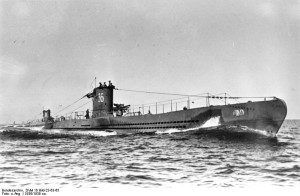Salvage team discovers sunken WWII ship full of rupees
As the dark of the night invaded the skies of the South Atlantic Sea, two torpedoes swiftly sank the SS City of Cairo on November 6, 1942. The vessel, registered in Liverpool in 1915, was traveling from India to the UK, carrying numerous passengers and cargo, including 2,000 boxes of silver rupees intended to aid in the financing of the British effort in World War II. The ship departed the port of Cape Town just five days earlier and had started the journey to its last stop in Pernambuco, Brazil, before heading home to London. The loud noise and smoke caused by the steam engines made her (the SS City of Cairo) a vulnerable vessel: in addition to her slow speed, the smoke made her an easy target as she travelled long distances, unescorted during a time of war.
A German U-68 sighted the SS City of Cairo early in the evening on November 6. Led by Karl-Friedrich Merten—who was responsible for sinking more than 100,000 tons worth of shipment off the coast of South Africa in only two months—the German submarine followed her trace and fired two torpedoes in the span of half an hour, fatally sinking the British ship. Following the attack, Merten approached the area where the vessel had sunk, 700 km south of St. Helena, and sarcastically indicated to the survivors where they could find the nearest land. The German captain had little faith that any of them would survive.

For years, the ship and its cargo had been presumed lost until 2011, when a British salvage team led by John Kingsford located an “unnatural object” among the underwater mountains and ridges of their South Atlantic search area. In 2013, still confused as to what it could be, the salvage team signed a contract with the UK to explore what remained of the British vessel, which had been lying on the ocean floor for 70 years. In a mission that involved powerful sonars and robotics, the researchers used innovative techniques to explore the ship’s wreckage. To date, it is the deepest salvage operation in history.
The depth of the dive caused serious difficulties that had to be quickly overcome during the mission, according to members of the salvage team. The team found that the ship had been broken in two after its sinking, certain parts obscured by a thick layer of mud. The search operation was finished by September 2013, but only recently did the British Ministry of Transport gave permission to the team to announce the news.
The highlight of the discovery and the main purpose of the search was the recuperation of the boxes of silver rupees, which amounted to around $50 million. The coins have now been melted and sold in the UK. The undisclosed profits will be divided between the British Treasury, which technically owns the coins, and the salvage search team, who will receive a percentage of the sales. The team also found the propeller for the second torpedo that hit the City of Cairo.
On the last day of the search operation, the divers of the salvage team left a plaque in honor of those who died as a result of the sinking of the City of Cairo. It read, “We came here with respect.” Kingsford, the team leader, also stated that “it was a very special salvage” that marked a significant find for the team.
However, the case of the City of Cairo is not unique. During World War II, German U-boats hit over 1,700 ships spread among 650 allied convoys. Britain was the nation hit the hardest, followed by the United States. Most of the vessels attacked carried large sums of money or resources—the SS Gairsoppa, another British steam merchant ship that was sunk near the Irish coast in 1941 and went down with around 110 tons of silver on board—that would certainly have helped the allies’ efforts against the Germans.
Despite their importance in cutting the enemy off from resources, there is little coverage on the German naval attacks throughout the years. The fact is that U-boats or Unterseeboot, as they are referred to in German, played a key role in economic warfare. Germans attacked merchant vessels, and consequently disrupted the logistics of the enemy by depriving them of shared resources. This strategy is known as “commerce raiding” and proved to be quite effective for the Nazis, who instead of enforcing a blockade or engaging the enemy in a direct way, were able to create significant harm with minimal effort.
Today, we regard those rescued coins as traces of the past, sunken mysteries of sorts. However, in reality, they show a richer side of WWII often unexplored.
